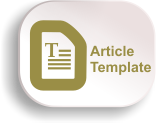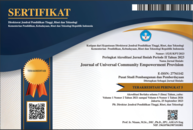Training of Breast Examination (Best Self-Examination) in the Order of Improving the Independence of Adolescent Care of Reproductive Health in the Pandemicovid-19 Time at Senior High School 1 Telaga
DOI:
https://doi.org/10.55885/jucep.v1i2.65Keywords:
SADARI, Teens, Covid-19Abstract
Producer health is a problem that needs special attention among teenagers. Public awareness and knowledge of cancer including risk factors, prevention efforts, symptoms that arise, and early detection of cancer is still lacking so it is necessary to increase knowledge for young women. 1 Lake in the context of increasing the independence of adolescents who care about reproductive health during the covid-19 pandemic. From the results achieved with this activity, the school is very supportive and gives thanks to the Muhammadiyah University of Gorontalo in carrying out the activities that have been carried out. The conclusion of this community service is that counseling can increase the knowledge of participants in breast self-examination (BSE) training
References
Boudreau, D. M., Yu, O., Chubak, J., Wirtz, H. S., Bowles, E. J. A., Fujii, M., & Buist, D. S. (2014). Comparative safety of cardiovascular medication useand breast cancer outcomes among women with early stage breast cancer. Breast cancer research and treatment,144(2), 405-416.
Elder, G. H., Johnson, M. K., & Crosnoe, R. (2003). The emergence and development of life course theory. InHandbook of the life course(pp. 3-19). Springer, Boston, MA.
Hurley, S., Goldberg, D., Bernstein, L., & Reynolds, P. (2015). Sleep duration and cancer risk in women.Cancer Causes & Control,26(7), 1037-1045.
Kühn, S., & Rieger, U. M. (2017). Health is a state of complete physical, mental and social well-being and not merely absence of disease or infirmity. Surgery for Obesity and Related Diseases,13(5), 887.
Lancaster, J. B. (2017). Human adolescence and reproduction: An evolutionary perspective. InSchool-Age Pregnancy & Parenthood (pp. 17-38). Routledge.
Macias, A. (2017). Teacher-Led Professional Development: A Proposal for a Bottom-Up Structure Approach.International Journal of Teacher Leadership, 8(1), 76-91.
Pungur, L. (2007). Mentoring as the key to a successful student teaching practicum: A comparative analysis. InHandbook of teacher education(pp. 267-282). Springer, Dordrecht.
Scheffler, C., & Hermanussen, M. (2018). Growth in childhood and adolescence.The International Encyclopedia of Biological Anthropology, 1-11.
Downloads
Published
How to Cite
Issue
Section
License
Copyright (c) 2021 Journal of Universal Community Empowerment Provision

This work is licensed under a Creative Commons Attribution-ShareAlike 4.0 International License.
















